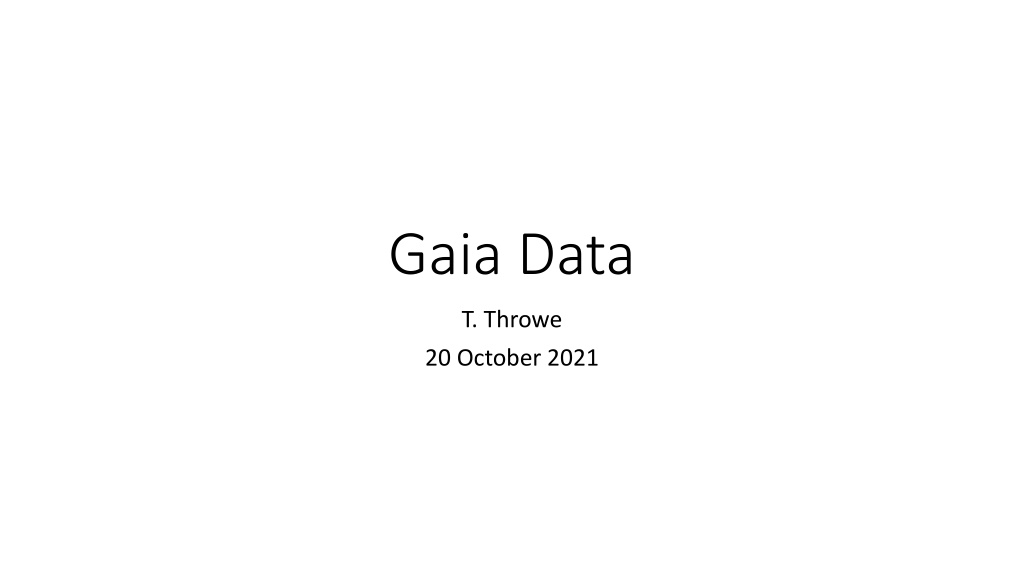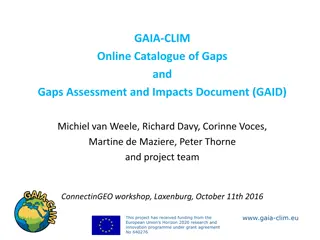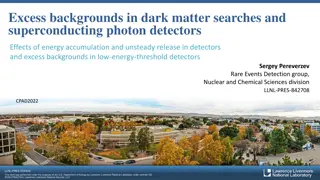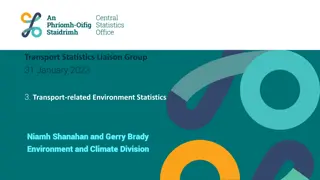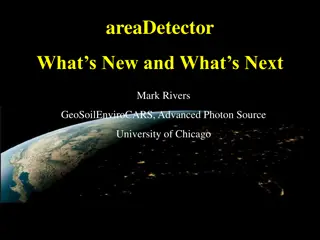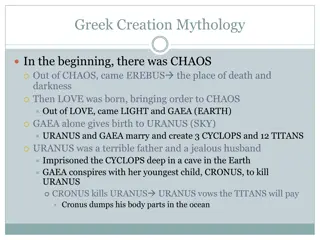Understanding Gaia Data Releases and Utilizing the Information
Gaia, a satellite managed by the European Space Agency and positioned at the L2 Lagrange point, has released various data sets, including the recent Early Data Release 3 (EDR3). This release contains a vast amount of astronomical sources with detailed parameters. Users can access the data through interactive searches, visualizations, and a convenient web API, which simplifies the data retrieval process for researchers and enthusiasts alike.
Download Presentation

Please find below an Image/Link to download the presentation.
The content on the website is provided AS IS for your information and personal use only. It may not be sold, licensed, or shared on other websites without obtaining consent from the author. Download presentation by click this link. If you encounter any issues during the download, it is possible that the publisher has removed the file from their server.
E N D
Presentation Transcript
Gaia Data T. Throwe 20 October 2021
Gaia Satellite managed by the European Space Agency Launched in December 2013 Positioned at the L2 Lagrange point 1.5 million km from Earth Three data releases Data cited in papers we have examined What is involved in using the data?
Gaia Early Data Release 3 The Gaia collaboration is making the third release of their data in two parts. Early Data Release 3 (EDR3) was released on 3 December 2020 and the final release will be sometime in early 2022. EDR3 contains 1,811,709,771 sources 1,467,744,818 sources with the full astrometric solution (position, parallax and proper motion) Radial velocities are not yet available, but 7,209,831 from DR2 are included Parameter table on next slide
EDR3 Main Source Table 99 Columns, including ra : Right ascension (double, Angle[deg]) dec : Declination (double, Angle[deg]) parallax : Parallax (double, Angle[mas]) pm : Total proper motion (float, Angular Velocity[mas/year] pmra : PM in right ascension direction (double, Angular Velocity[mas/year]) pmdec : PM in declination direction (double, Angular Velocity[mas/year] ) dr2_radial_velocity : Radial velocity from Gaia DR2 (float, Velocity[km/s]) l : Galactic longitude (double, Angle[deg]) b : Galactic latitude (double, Angle[deg]) Associated errors and correlations of the above
Data Availability Websites where you can do interactive searches and visualizations https://www.cosmos.esa.int/web/gaia/early-data-release-3 Overview https://gea.esac.esa.int/archive/ Download data files - Gaia source 616GB Interactive search https://gea.esac.esa.int/archive/visualization/ Visualization of the data set Programing API
API There is a web API for the data using something called TAP or Table Access Protocol To make things really simple, there is a Python module called astroquery which contains interfaces to many astronomical data sources including Gaia. It is used as: from astroquery.gaia import Gaia Gaia.load_tables(only_names=True) # retrieve table names from database Gaia.launch_job_async("SELECT * FROM gaiaedr3.gaia_source WHERE gaiaedr3.gaia_source.parallax > 150.0;",dump_to_file=True, output_format='csv', output_file='150mas.csv')
Parallax In the previous example, the query selected sources with a parallax greater than 150 mas or within about 22 light years Results were returned almost immediately, a nice feature of databases There were 113 sources returned by the query and stored in a 96kB csv file From the returned data, used pandas to load into python and then one can then plot the position of the 113 objects
Stellar Velocity Given the redial velocity and proper motion, a star s total and component velocities can be determined. The total velocity is: 2 2 ? ??? 1.296?109 1 ? = Where rv is the dr2_radial_velocity, pm is the total proper motion, and dkm is the distance to the star in km Since pm is in mas/year, 2 ? ??? the number of seconds in a year ? is in km/s Only 28 of the 113 sources had radial velocities For Sun motion, use the Solar apex and Solar antapex and 13.4 km/s Solar apex - RA: 18h 28m 0s, dec 30 N or RA: 277.0 degrees, dec: 30 degrees Solar antapex - RA: 6h 28m 0s, dec 30 S or RA: 97.0 degrees, dec: -30 degrees ??2+ (??) 3.156?107 1.296?109 is the conversion of mas to km and 3.156?107 is
Distribution of Radial Velocities
Located Star with Stellarium ra: 21h 17m 15.2697s, dec: 38 52 02.502 In the constellation Microscopium Lacaille 8760,AX Mic, HIP 105090, SAO 212 886, HD 202560 Red Dwarf 12.9 light years away rv = 20.56 km/s, pmra = -3258.97 mas/yr, pmdec = -1145.86 mas/yr Came within 12 ly of sun 20,000 years ago Plot shows a much closer approach, so missing something
Hertzsprung Hertzsprung Russell diagram Russell diagram Gaia data also includes phot_g_mean_mag : G-band mean magnitude (float, Magnitude[mag]) phot_bp_mean_mag : Integrated BP mean magnitude (float,[mag]) phot_rp_mean_mag : Integrated RP mean magnitude (float, Magnitude[mag]) bp_rp : BP - RP colour (float, Magnitude[mag]) bp_g : BP - G colour (float, Magnitude[mag]) g_rp : G - RP colour (float, Magnitude[mag]) So plot phot_g_mean_mag vs. g_rp
Messier 13 For Messier 13 ra: 16h 41m 41.24s = 16.6948 dec: +36 27 35.5 = 36.460 Apparent dimension: 20 arcminutes = 0.333 degree Gaia data query job1 = Gaia.launch_job_async("SELECT * FROM gaiaedr3.gaia_source WHERE CONTAINS(POINT('ICRS',gaiaedr3.gaia_source.ra,gaiaedr3.gaia_source.dec), CIRCLE('ICRS',16.6948,36.460,0.333))=1;", dump_to_file=True, output_format='csv', output_file='m13.csv ) ICRS is International Celestial Reference System Returned 2972 sources
Problems Distance to M13 is 22.2 kly (6.8 kpc) or parallax of 0.15 mas Most of the Gaia sources returned are not part of M13
NGC 869 Recent Astronomy Picture of the Day ra: 02h 19.1m = 34.775 degrees dec: +57 09 = 57.15 degrees distance: 7.6 kly or 2.3 kpc (0.435 mas) apparent dimension: 30 = 0.5 degrees Query job = Gaia.launch_job_async("SELECT * FROM gaiaedr3.gaia_source WHERE CONTAINS(POINT('ICRS',gaiaedr3.gaia_source.ra,gaiaedr3.gaia_source.dec),CI RCLE('ICRS',34.775,57.15,0.5))=1;" , dump_to_file=True, output_format='csv', output_file='NGC869.csv ) Returns 55687 sources
NGC 869 Parallax
H-R Cut around 0.435
GaiaEDR3 gaia_source Table Columns solution_id ra designation ra_error source_id dec random_index dec_error ref_epoch parallax parallax_error pmdec ra_pmdec_corr parallax_pmdec_corr parallax_over_error pmdec_error dec_parallax_corr pmra_pmdec_corr pm ra_dec_corr dec_pmra_corr astrometric_n_obs_al pmra ra_parallax_corr dec_pmdec_corr astrometric_n_obs_ac pmra_error ra_pmra_corr parallax_pmra_corr astrometric_n_good_obs_al astrometric_n_bad_obs_al astrometric_gof_al astrometric_chi2_al astrometric_excess_noise astrometric_excess_noise_sig astrometric_params_solved astrometric_primary_flag nu_eff_used_in_astrometry pseudocolour pseudocolour_error ra_pseudocolour_corr dec_pseudocolour_corr parallax_pseudocolour_corr pmra_pseudocolour_corr pmdec_pseudocolour_corr astrometric_matched_transits visibility_periods_used astrometric_sigma5d_max matched_transits new_matched_transits matched_transits_removed ipd_gof_harmonic_amplitude ipd_gof_harmonic_phase ipd_frac_multi_peak ipd_frac_odd_win ruwe scan_direction_strength_k1 scan_direction_strength_k2 scan_direction_strength_k3 scan_direction_strength_k4 scan_direction_mean_k1 scan_direction_mean_k2 scan_direction_mean_k3 scan_direction_mean_k4 duplicated_source phot_g_n_obs phot_g_mean_flux phot_g_mean_flux_error phot_g_mean_flux_over_error phot_g_mean_mag phot_bp_n_obs phot_bp_mean_flux phot_bp_mean_flux_error phot_bp_mean_flux_over_erro r phot_rp_mean_flux_over_erro r phot_rp_n_blended_transits phot_bp_mean_mag phot_rp_n_obs phot_rp_mean_flux phot_rp_mean_flux_error phot_rp_mean_mag phot_bp_n_contaminated_tran sits phot_bp_rp_excess_factor phot_bp_n_blended_transits phot_rp_n_contaminated_tran sits bp_g phot_proc_mode bp_rp g_rp dr2_radial_velocity dr2_radial_velocity_error l dr2_rv_nb_transits b dr2_rv_template_teff ecl_lon dr2_rv_template_logg ecl_lat dr2_rv_template_fe_h
